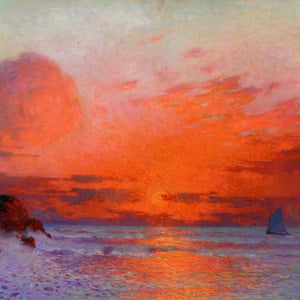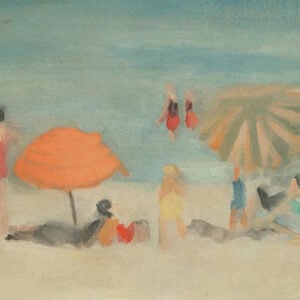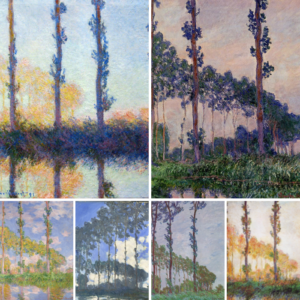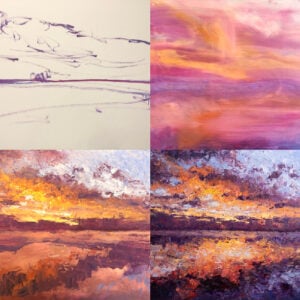Since ancient times artists have portrayed arrangements of inanimate objects. However, still-life painting turned into an independent genre until the late 16th century when Flemish and Dutch artists captured intricate compositions of everyday objects. In the early days of the art form, these scenes were used to represent prosperity and were also infused with religious symbols. Over time the genre became popular across Europe and the US and took many shapes and forms. In this post, we explore the work of 20 artists that excelled in the genre.
- Michelangelo Merisi da Caravaggio (1571-1610)
- Ambrosius Bosschaert the Elder (1573-1621)
- Clara Peeters (1594-1657)
- Jacob Van Es (1596-1666)
- Pieter Claesz (1597-1661)
- Francisco de Zurbarán (1598-1664)
- Giovanna Garzoni (1600-1670)
- Louise Moillon (1610–1696)
- Gerrit Dou, also called Gerard Do (1613-1675)
- Willem van Aelst (1627-1683)
- Adriaen van der Spelt (1630-1673)
- Rachel Ruysch (1664-1750)
- Jean-Baptiste-Simeon Chardin (1699-1779)
- Luis Meléndez (1716-1780)
- Francisco Goya (1746-1828)
- Sarah Miriam Peale (1800-1885)
- Gustave Courbet (1819-1877)
- Lilly Martin Spencer (1822-1902)
- Henri Fantin-Latour (1836-1904)
- Paul Cézanne (1839-1906)
- Key Takeaways
- Thanks for Reading!
Michelangelo Merisi da Caravaggio (1571-1610)
Caravaggio is famous for the intense realism of his large-scale religious and mythological works and his volatile character. He is also celebrated for his use of the chiaroscuro technique. Even if his life was brief, Caravaggio influenced the artists of his time and later art movements, mainly Baroque art and 19th-century Realism. The painting we see here is attributed to the artist’s hand and is only one of the two still life scenes linked to him (the other one is Basket of Fruit). Contrary to other of Caravaggio’s artworks, where dramatic light contrasts are the common feature, here a uniform light covers the composition populated by an arrangement of fruits and vegetables that bears a message of life and fertility and that, to some, also has sexual connotations. It has been said the artist painted this scene inside his home where he cut holes in the ceiling to get the right amount of light!

Ambrosius Bosschaert the Elder (1573-1621)
Ambrosius Bosschaert the Elder was one of the pioneers of Dutch still-life painting. He was the son of artist Ambrosius Bosschaert II, who trained his son. Ambrosius began his career capturing rare flowers in botanical gardens and made some drawings for the botanist Carolus Clusius. Later on, he used these scientific drawings to compose his paintings. After the Spanish troops reconquered Antwerp, the Protestant Bosschaert family fled to the Northern Netherlands. While there, the artist had access to a beautiful botanical garden which was a source of inspiration for his still-life paintings. In this artwork, the artist’s ability to accurately capture flowers and insects is evidenced. Different species of flowers are arranged in a basket. The pink carnation, white rose, and yellow tulip that lie on the table capture our eyes. The presence of insects, such as butterflies and bees, reminds us of the brevity of life but also of the beauty of nature.

Clara Peeters (1594-1657)
Clara Peeters was one of the very few female painters practicing actively in 17-century Europe. While there is no evidence of her background, scholars believe the artist was a student of Osias Beert, a famous still-life artist from Antwerp. By 1612, Peeters was painting many realistic still lifes frequently featuring groupings of valuable objects, such as metal goblets, gold coins, and rare flowers, which she placed on narrow ledges. One of the artist’s most famous works is Still life with fish and cat. In this work, she depicted the abundance of a household with great detail. The scales of the different types of fish stacked on top of each other stand out as well as the cat included in the right lower corner that holds a fish under its paws. The whole composition has a dim light. Only a few accents of light grant the painting a dramatic touch.

Jacob Van Es (1596-1666)
Next to Clara Peeters and Osias Beert, Jacob was one of the leading representatives of the first generation of Flemish still-life painting. Over his career, he created many still-life scenes featuring realistic food or flower arrangements. There is not much information about Van Es’ life. Evidence suggests he was active primarily in Antwerp, where he became a Master in 1617, though he did not join the Guild of Saint Luke there until later on. He must have been successful as his paintings were documented in several of Antwerp’s 17th-century collections. Even the inventory of Peter Paul Rubens included two of his works. This still-life scene evidences the artist’s mastery of food’s textures and his ability to reflect the translucent nature of wine. As was common in this genre, the artist captured the passage of time by including a piece of bacon and sliced orange on a plate. The whole feeling of the painting is of abundance and prosperity.

Pieter Claesz (1597-1661)
Pieter Claesz was one of the most important still-life painters of his time. Most of the artist’s biography is uncertain, but many believe his work brings to mind the meticulously arranged table scenes of Clara Peeters and Osias Beert the Elder. Over the years Claesz’s table paintings portrayed a broad variety of food and beverage, tobacco devices, and musical equipment with extreme realism. Claesz’s innovative compositions and his ability to recombine the same set of objects into a myriad of original arrangements influenced artists in his hometown and beyond. The luxurious table setting we see here is a fine example of the artist’s talent. What first catches our attention is the big turkey pie in the background, adorned by a dead bird holding a flower. The wine jar also stands out as it reflects a window and part of the laid table, but also the blurred figure of the painter behind his easel. Here, the passage of time is symbolized through the half-eaten foods.

Francisco de Zurbarán (1598-1664)
Zurbarán is known for his portrayals of religious subjects. However, he also created still-life paintings where he masterfully captured the physical character of the objects and the space they inhabit. This painting by Zurbarán is the artist’s only signed and dated still life and has been described as a masterpiece of the genre. All the objects in this composition bear significant religious meanings. For example, the three-element layout could have been understood by religious Spaniards as an allusion to the Holy Trinity. At the same time, this work has been interpreted as an homage to the Virgin, with the oranges, their blossoms, and the cup of water alluding to her purity, and the thornless rose to her Immaculate Conception. Next to these meanings, the textures of the fruit are represented with great realism. The whole composition exudes a harmonious rhythm of lights and shadows.

Giovanna Garzoni (1600-1670)
Garzoni was an accomplished botanical artist of the 17th century who also produced still-life paintings. She was born into an artistic family and got acquainted with many artists and scientists that influenced her. Notably, the artist had an unconventional lifestyle as she never married and worked for various courts across Europe. For instance, she was employed by the Medici of Florence for 25 years. Over time, Giovanna developed a distinctive style for her still life scenes. She usually worked with tempera on vellum and added precise dots of paint that gave life to realistic compositions that featured native flora and fauna next to exotic species. This painting reflects the artist’s mastery of drawing and painting. It features a hyperreal depiction of a bowl of citrons that have been harvested from a tree. The presence of a fly on one of the fruits and of some flowers on the table hint at the passage of time.

Louise Moillon (1610–1696)
Moillon came from a family of artists and was exposed to painting from an early age. She also lived in a neighborhood where Protestant refugees from the southern Netherlands resided. Among them were many artists who introduced Louise to the tradition of tabletop still-life painting. Moillon, also a Protestant, became a leading member of this group and created still-life scenes populated by fruits and flowers. The artist was recognized during her lifetime and her work was collected by art patrons. However, starting in 1640, she took a 30-year break from painting to focus on her family. The artist’s still lifes, like the one we see here, including a method of illusionism known as trompe l’oeil (fool the eye). Moillon used devices, such as the open pomegranate which hangs slightly over the ledge, to create the impression that the space is closer to the viewer. The tactile quality of the lemons and oranges reinforces this illusion.

Gerrit Dou, also called Gerard Do (1613-1675)
Gerrit Dou is considered to be the founder of the Dutch painting school of the Leiden fijnschilderij, characterized by its small and smooth surfaces. The artist learned the art of engraving from his father and was a student of Rembrandt. Over the years, he specialized in genre scenes and is known for his trompe-l’œil “niche” works and candlelit night scenes with a heavy presence of chiaroscuro. Dou was a successful artist. As proof of this, his works were more expensive during his lifetime than those of Rembrandt. He is also known for his obsessive attention to detail as he could spend days working on a single element of his paintings. In this Vanitas the artist’s ability to reproduce details is evidenced. This scene is filled with books, prints, unfinished paintings, and a skull. A convex mirror is also located in the painting’s background, and it reflects a domestic scene. Next to this, a painting of what appears to be another still life scene hangs on a wall. The presence of a realistic skull, called Memento Mori (a Latin phrase meaning “Remember that you will die”), reminds us of the certainty of death.

Willem van Aelst (1627-1683)
Willem van Aelst, known as “The Dutchman,” spent many years in Florence where he painted still-life scenes that were acquired by members of the Medici family, such as Cardinal Leopoldo de’ Medici, an avid collector. The artist eventually settled in Amsterdam and continued to be favored by distinguished art patrons. Over the years he painted various types of still life paintings and was one of the first artists to portray hunting trophies in his compositions. This painting is a fine example of the type of hunting still life for which he became known. It features a realistic death pigeon that appears to have been just hunted. The composition is quite somber and is covered by a dim light.

Adriaen van der Spelt (1630-1673)
Over his career, Adriaen van der Spelt created still-life scenes where flower arrangements took centerstage. One of his most famous works is this still-life painting of a large flower garland that impressively displays 20 varieties of flowers. Among them, the artist featured a tulip, a 16th-century import from Persia that would become an icon of Dutch culture. Though a few of the blooms hiding in the background are beginning to decay, most of the composition speaks to the vitality of life. Notably, this flower arrangement is partially covered by a curtain painted by artist Frans van Mieris. The extremely realistic blue curtain refers to the common practice for protecting paintings but also to the tale of Parhassius, a talented Greek artist who fooled his rival in a painting competition. His opponent tried to pull back the curtain Parhassius had painted!
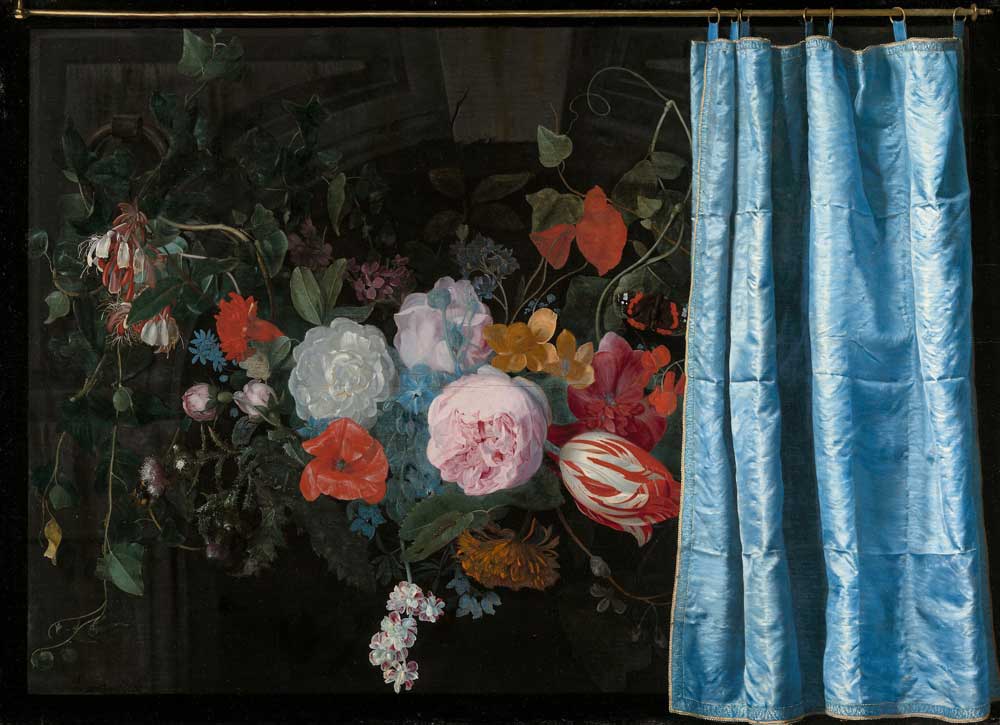
Rachel Ruysch (1664-1750)
Rachel Ruysch came from an illustrious background. Her grandfather, Pieter Post, was an architect, and her father, Frederik Ruysch, was a scientist. The artist’s father taught her how to accurately depict nature; at age 15 she was the apprentice of Willem van Aelst, also included in this list. Rachel was a popular artist. She was a member of the painter’s guild in The Hague and produced flower paintings for international clients. She also lived until her eighties, something uncommon at her time. In this still-life scene, a group of flowers takes center stage. We can even see the individual grains of pollen inside each of the flowers of this pyramid-shaped composition. While this work features some elements of the picture type known as Vanitas, which stressed the inevitability of death, scholars doubt this was Ruysch’s intention. Life and not death seem to be highlighted through the insects placed on some of the stems.

Jean-Baptiste-Simeon Chardin (1699-1779)
Chardin’s still-life paintings depict humble objects and foods. Contrary to other still-life artists, Chardin selected items from his home as subjects based on their material qualities and not for their symbolic meaning. His skill at recording objects was commented on in the 19th century: “.. never, perhaps, has the material fascination of painting dealing with objects of no intrinsic interest transfiguring them by the magic of handling been developed so far…” Chardin was recognized during his lifetime and praised by the Academy’s members. However, as the taste changed in favor of historic painting, his art lost popularity. This painting reflects the artist’s style as it portrays a piece of raw meat hanging from a metal hook next to other kitchen utensils. The garlic and leek are represented with great realism. The reflection of light on the jar and bowl captures our attention as well as a piece of white fabric located on the left side of the painting.

Luis Meléndez (1716-1780)
Meléndez’s hyper-realistic still-life paintings introduce elements of the everyday life of the middle classes in 18th-century Madrid. Eating habits, kitchen implements, different foods and drinks, and vessels are all displayed across his compositions. Notably, the artist did not work from complete setups. Rather he studied and painted his objects one at a time, starting with those in front and finishing with the tabletop and background. The artist’s approach to the genre is appreciated in this artwork featuring pears and a melon next to everyday kitchen utensils painted with sober yet sensuous realism. Scholars believe this still life may be from a series said to represent “every species of food produced in Spain” that Meléndez created for the king’s summer house. Ironically, many of these works were painted at a time of severe food shortages. The artist himself had no money and once said his brush was his only possession.
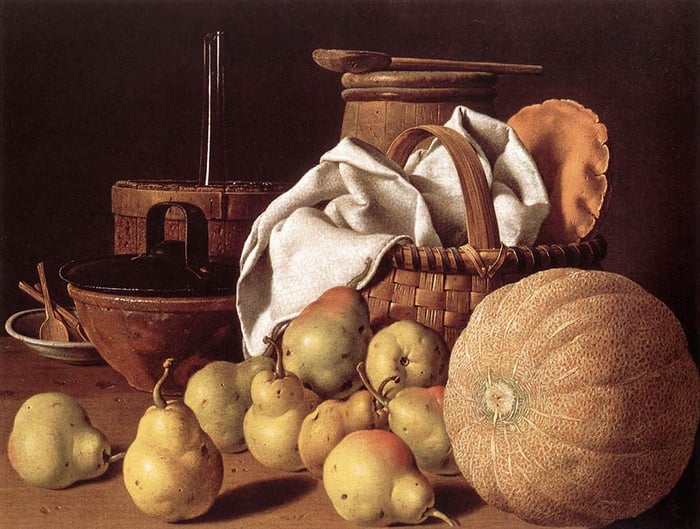
Francisco Goya (1746-1828)
Francisco de Goya’s expressive paintings marked the development of future art movements as he introduced dark psychological and political themes in his dramatic compositions. Goya produced at a frantic pace yet he only painted around a dozen still lifes in his 60s when he focused on creating private paintings in solitude. One of the most famous ones is titled Still Life with Golden Bream. In this painting illuminated by moonlight, the artist portrayed the beauty of the fish while hinting at the animals’ death. The painting has a mysterious feel, and the process of dying is portrayed masterfully. At the same time, the unstable arrangement of fishes grants the composition a dramatic touch. Some have suggested the scene relates, on a symbolic level, to the human slaughter that resulted from Spain’s conflict with France.

Sarah Miriam Peale (1800-1885)
Sarah Miriam Peale was a forward-thinking artist. Next to her uncle Charles Willson Peale, her father James Peale, and other relatives, she was part of America’s first artistic dynasty. Sarah, who was trained by her father and uncle, specialized in creating miniature portrait paintings but also painted realistic still-life scenes. Together with her elder sister, the miniaturist Anna Claypoole Peale, Sarah was one of the first women to be elected to the Pennsylvania Academicians, a group of artists active in the Pennsylvania Academy of the Fine Arts. This still-life scene, titled Peaches and grapes in a porcelain bowl, reflects Sarah’s skills. Notably, all the grapes are depicted in a state of perfection and not decay, which was common in the genre. The light is directed toward the grapes that rest on the table and to the peaches in the bowl, which have intricate patterns and textures.

Gustave Courbet (1819-1877)
Courbet was the main exponent of Realism. Next to being an artist, Courbet got involved in the political world and even served jail time for his subversive ideas. The artist created this still-life painting of a bowl of apples during his imprisonment for his involvement in the Paris Commune, a radical government that briefly governed Paris. While in jail he was allowed to paint but without using live models. The artist’s sister brought Courbet flowers and fruits, and from these gifts, he started exploring still life, a genre he had neglected beforehand. Contrary to the tradition of Dutch still-life painting, where the fruits and flowers portrayed the passage of time, the apples appear ripe here. The composition is populated by a dim light, probably from the somber place where the artist captured this image. However, the latter also connects with the affinity he had for shadowed canvases.

Lilly Martin Spencer (1822-1902)
Lilly Martin Spencer grew up in a household supporting women’s talents. Best known for her portrayals of domestic life in mid-19th century America, Spencer was also a talented painter of still life scenes. Impressively, this artist supported a family of 8 children with her art. Once married Lilly continued her formal training and enrolled in evening drawing classes at the National Academy of Design. She was also named an honorary member of the Academy, the highest recognition the institution then permitted women. The artist’s mastery of drawing and painting is seen in the painting Oranges, Nuts, and Figs in which she captured a bowl with different fruits and nuts. While the oranges appear to be at the peak of perfection, the grapes are starting to decay adding a sense of immediacy and hinting at life’s cycles.

Henri Fantin-Latour (1836-1904)
Henri Fantin-Latour lived during the advent of Impressionism and was a friend of Manet. However, he stayed faithful to the Realist tradition initiated by Courbet. Like his teacher, Courbet, the artist believed his paintings should not depict unrealistic images and that the subjects were to be portrayed as they were. The artist also saw a connection between color and poetry and wanted his paintings to be a symphony of colors. Henri’s ideas are reflected in the many still-life paintings he created, which were his main source of income. In this painting, we see geometric shapes and organic lines that bring to life a composition where a flower pot, a bowl of pears, and a group of pomegranates coexist in perfect balance. The similar color palette of these three elements creates a harmonious and balanced composition.

Paul Cézanne (1839-1906)
Paul Cézanne set the ground for the emergence of modern art movements. Over time, Cézanne experimented with still-life painting. In these paintings, nothing was random as the artist tirelessly rearranged the objects in his studio, often playing with myriad viewpoints. Next to small sculptures, household objects, and furniture, Cézanne was also drawn to fruit, which appears freshly picked in his paintings. The latter is seen in the painting Still Life with Apples and Peaches. When looking at this painting Cézanne’s words come to life: “they [fruits] love having their portraits done. . . . They exhale their message with their scent. They reach you with all their smells and tell you about the fields they’ve left, the rain that made them grow, the dawns they watched…”

Key Takeaways
- Starting in the 1600s, still-life painting flourished in Flanders and in The Netherlands. For this reason, many of the artists from this list are from these regions.
- For centuries still-life painting was associated with hidden religious symbolism and, over time, divided into different sub-genres including fruit and vegetable studies, meal still-lifes, and Vanitas paintings.
- During the 17th-century Dutch Golden Age, Vanitas paintings, which contain collections of symbolic objects that reflect the inevitability of death and the transience of pleasures, were extremely popular.
- Memento mori still lifes (a Latin phrase meaning ‘remember you must die) are connected to Vanitas as they reminded the viewer of the shortness of life through symbols like skulls and extinguished candles.
- Women artists working in this genre were recognized during their lifetime. The latter relates to the fact that this subject matter was viewed as more appropriate for the female gender.
- Over time artists experimented with the genre and created compositions that captured everyday life habits instead of religious meanings. The genre also continued to be reinterpreted throughout the 20th Century.
- Through still life painting, you can practice your drawing and painting skills and rediscover the objects that surround us!
Thanks for Reading!
Thanks for taking the time to read this post. I appreciate it! Feel free to share with friends. If you want more painting tips, check out my Painting Academy course.
Happy painting!

Dan Scott
Draw Paint Academy

